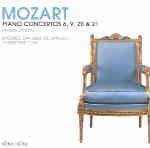Among Mozart concerto recordings using period instruments, the four performances reissued here leave a particularly sour aftertaste. For starters, in the B-flat and E-flat works the overly close engineering shoves the Ensemble Baroque de Limoges upside your head, with all instruments scrapping away at the same loud, virtually unvarying dynamic level. Solo instrumental licks often protrude at illogical moments (the horns in K. 238’s finale). Granted, Patrick Cohen’s fortepiano receives better treatment in the mix, but his soft-edged rhythmic sense and habit of rounding off phrases that need to press forward flatten the music’s drama and wit (except in the cadenzas, where he becomes more assertive and assured). The manner in which he slightly delays the top of his opening phrase in K. 271 is a dead giveaway, as well as his slightly rushed passagework in the same concerto’s finale.
The D minor and C major concertos, recorded live, benefit from a more resonant acoustic yet still suffer from skewed balances. Listen to the D minor’s first movement and try to hear the strings in massed tuttis (you can’t!)–or wonder why, in the second subject, the solo flute emerges louder than the whole orchestra. Cohen tries to sustain his slow and square pace for the central Romance with inflections of phrase and dynamic hairpins that are better suited to Moskowski than Mozart. And his ponderous, arrhythmic treatment of the Allegro Assai’s opening must be heard to be believed. Soloist and orchestra do far better in the C major K. 467, and generally leave the music’s inherent drama and lyric simplicity to speak for themselves. In the main, if you’re seeking these works on period instruments, the Bilson/Gardiner cycle on DG offers a level of orchestral finesse, ensemble polish, cultivated pianism, and sonic splendor that leaves the present reissue in the dust, notwithstanding its adequate K. 467.
































